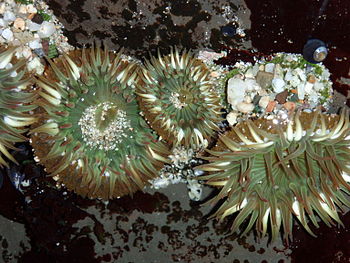Sea anemones are a very common offering in the marine aquarium trade. All types of species are brought in from carpet anemones, filter feeding tube anemones to rose bulb tip anemones.
 |
| Sea Anemones at California tideppols. Sea Anemones look as plants, but they are animals and they are predators. (Photo credit: Wikipedia) |
While most people think they are corals, sea anemones are actually under the phylum Cnidaria, which strangely enough, includes the jellyfish. They do share a common trait with corals, however. Within their bodies are contained symbiotic algae called zooxanthellae which extract energy from light and feeds the sea anemone with their by-products.
Where they differ spectacularly from corals are their ability to move from location to location. This behavior is commonly seen in captivity where the sea anemone will move around the aquarium until it has found a suitable spot.
Unfortunately, this behavior is undesirable mainly because their tentacles contain stinging cells used to capture prey and as a defense mechanism. As they move around the aquarium, they may come into contact with and sting any corals that are present.
The sea anemone shares a symbiotic relationship with a number of creatures in the wild. The most famous of their hosts are the clown fish family. They also play host to damselfish, certain crabs and a variety of anemone shrimp that rely on it for protection from predators.
They are a tricky species to care for in a marine aquarium as they require strong water flow and very strong lighting to do well in the long run. Should they die, they literally begin to melt. Which can really foul up the water?
Unfortunately, the great number of these creatures end up dying in captivity due to improper conditions. This is a shame because in the wild they are known to reach a lifespan of a hundred years or more. Some experts have pointed out that they may not even die if conditions remain good.
The family of Sea Anemone also contains a number of pests. Among them, the infamous Aiptasia and Majano anemones. Unlike their prettier cousins, these pests thrive in captivity and can quickly take over the entire aquarium.
|

No comments:
Post a Comment